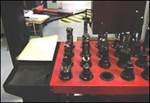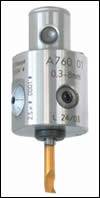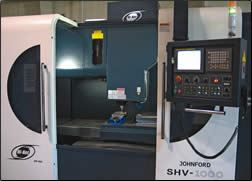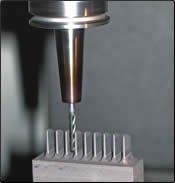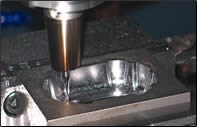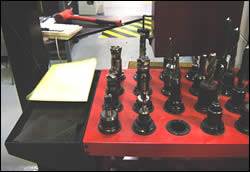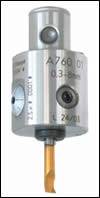High Speed Balancing Act
Think you’re using toolholders properly balanced for high-speed machining? Well, you may have to think again.
Moldmakers use balanced toolholders to get the most out of their
high-speed machining centers, but how do you guarantee your toolholders
are properly balanced? Different mold-makers may try different methods. For example, some use shrink fit to guarantee consistent results, others check the balance of every cutting tool in a toolholder before machining, and others rely on their tooling suppliers to properly balance tool-holders.
Test cuts and independent testing of tools on high-speed machining centers revealed inconsistent results when application engineers checked each and every variable of the HSM process. The problem was traced back to the toolholders—not every one was properly balanced to spec, even when it came with a certificate.
Toolholders from five leading tooling manufacturers were tested and while some toolholders were balanced exactly as certified, plenty of others were unbalanced. In some cases, it was discovered that toolholders certified as being balanced to 20,000 rpm weren’t acceptable to run over 5,000 rpm, which is a problem if you’re doing high-speed machining.
Why Use Balanced Toolholders?
Using unbalanced toolholders at 15,000 rpm and higher is like putting unbalanced tires on a high-performance sports car. Sure, you can do it, but you’ll end up being sorry in the long run. The benefits of balanced toolholding include the ability to take faster cuts at higher speeds and chip loads while still maintaining finishes and tool life. In many cases, shops also can improve surface finishes and tool life.
Ideally, toolholders should be balanced with the cutting tools already clamped into position. Every time you clamp a cutting tool or remove it, you’re impacting the balance. It’s like taking a balanced tire off a rim, then putting it back on and saying it’s balanced. It’s not.
Collet Holders Versus Shrink Fit
Various tooling suppliers and shops have differing opinions on whether or not collet holders can withstand the rpm of high-speed machining. Many engineers come down squarely on the side of prebalanced shrink fit toolholders for machining at speeds higher than 8,000 rpm. Shrink fit costs more initially, but in the long run, you’ll save money and gain longer tool life.
Shrink fit toolholders have no moving parts, so shops get better repeatability over a long period of time. The finish is better because the runout is better and because it runs truer and is a more rigid holder than a collet system. If it’s balanced properly from the start, you can count on it being balanced in three years versus replaceable collet toolholding.
Moldmakers need to evaluate in-house tool balancing. When it comes to time and money, anyone with two or three HSM centers should own a balancing machine. They are expensive, but it’s a good investment and with the right training, you’ll quickly gain your money back. If you can’t afford a balancer, find a balancing service with a good reputation. Tell them you want three certificates for every fifth tool balanced.
For shops continuing to use collet holders, it is recommended that you use prebalanced collets with small nuts that don’t have splines or wrench squares on them. They balance out better than ER collets, but they’re still not enough for shops running 24,000 rpm or higher; however, if you must use collets, make sure you have them balanced to the rpm your tools will be running. In addition, check the balance of every toolholder entering your shop. And learn the rpm for the toolholders you’re using. For example, an ER 32 collet holder shouldn’t run over 6,000 rpm.
Buyer Beware
Moldmakers also should take on a buyer beware attitude when it comes to prebalanced toolholders. Simply put, you get what you pay for. If someone sells you a cheap holder that is balanced for 20,000 rpm, it’s probably not. And thoroughly investigate any outside balancing services. Would you trust a 15-year-old kid in a rundown garage to balance the tires on your new Corvette? Maybe it’s okay for the old pickup truck, but not for that high-performance vehicle.
In addition to using reputable suppliers, it’s recommended that end users educate themselves on the types of toolholders available and be more diligent about checking tools coming into their shops. Anyone serious about high-speed machining should consistently check their tooling as they continue to use it. In fact, moldmakers should put a preventative maintenance program in place that checks HSM tooling at regularly scheduled intervals.
Related Content
Machining Center Spindles: What You Need to Know
Why and how to research spindle technology before purchasing a machining center.
Read More6 Ways to Optimize High-Feed Milling
High-feed milling can significantly outweigh potential reliability challenges. Consider these six strategies in order to make high-feed milling successful for your business.
Read MoreRevisiting Some Hot Runner Fundamentals
What exactly does a hot runner do? If you’ve been in the injection molding industry for any length of time, you might think the answer is obvious, but it is not.
Read MoreThe Benefits of Hand Scraping
Accuracy and flatness are two benefits of hand scraping that help improve machine loop stiffness, workpiece surface finish and component geometry.
Read MoreRead Next
Holders/Cutters/Inserts Combination Maximizes Productivity
A switch in cutting tools triples the output at a die stamping facility.
Read MoreHigh-Speed Collet Toolholder Or Shrink-Fit Tooling
An in-depth look at the benefits of a quality high-speed collet toolholder reveals advantages over shrink-fit tooling for most high-speed applications.
Read MoreMaximum RPM Machining: Necessities of High-Speed Moldmaking
Mold shops will thrive if they practice an ‘all-aspects’ process to HSM, which includes the machine, cutting tool, toolholder, proper balance and application support.
Read More
